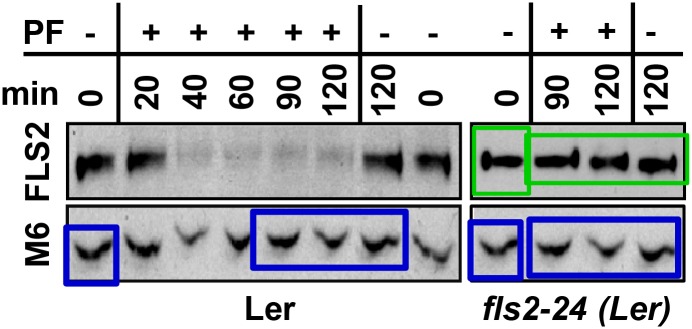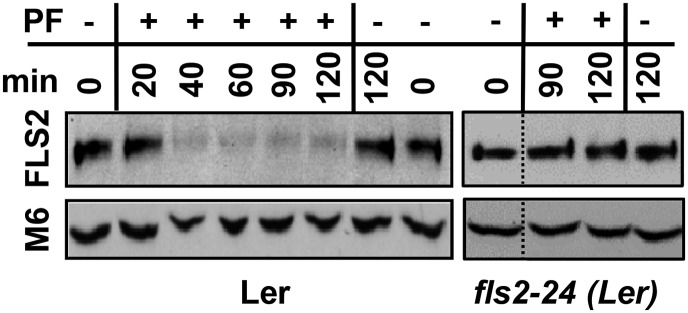Smith J.M., Salamango D.J., Leslie M.E., Collins C.A., and Heese A. Sensitivity to Flg22 Is Modulated by Ligand-Induced Degradation and de Novo Synthesis of the Endogenous Flagellin-Receptor FLAGELLIN-SENSING2.
The published version of Figure 1A of this article contains the following mistakes. The MPK6 loading control for fls2-24 was duplicated (blue boxes). For fls2-24, the 90 (+), 120 (+), and 120 (−) min samples were not identified as being incorrectly cropped to join them with the control from the same blot [i.e. the 0 (+) min lane was from the same gel as the 90 (+), 120 (+), and 120 (−) min samples (green boxes) but with intervening lanes removed]. These mistakes have been corrected. A stippled black line is included to indicate spliced segments from noncontiguous gel lanes that were derived from the same gel. The legend of the figure has been modified accordingly for clarity. The original data have been submitted to the journal for inspection during this correction process.
Figure 1.
Original: Flg22-induced degradation of endogenous FLS2 is ligand, dose, and time dependent. A and B, Time dependency and specificity in Ler seedlings. Ler wild-type and fls2-24 mutant seedlings were elicited in the presence (+) or absence (−) of 10 μm flg22 (A) or with 1 μm of indicated PAMPs (B) for indicated times. C, Dose and ligand dependency in Col-0 leaves. Col-0 wild-type leaf strips were elicited with (+) or without (−) indicated PAMP with indicated concentration for 0 or 60 min. For immunoblot analyses, total protein extracts were probed with αFLS2 (FLS2), αCalnexin (Caln), or αMPK6 (M6) antibodies. Probing with the latter two antibodies served as loading controls. Each experiment was done at least three times with similar results. AF, Inactive flg22 (from A. tumefaciens); E, elf26.
The original conclusions of this article are not affected by these corrections. The corrected Figure 1A and complete legend appear below.
Figure 1.
Corrected: Flg22-induced degradation of endogenous FLS2 is ligand, dose, and time dependent. A and B, Time dependency and specificity in Ler seedlings. Ler wild-type and fls2-24 mutant seedlings were elicited in the presence (+) or absence (−) of 10 μm flg22 (A) or with 1 μm of indicated PAMPs (B) for indicated times. The stippled black line in A indicates noncontiguous lanes derived from the same gel. C, Dose and ligand dependency in Col-0 leaves. Col-0 wild-type leaf strips were elicited with (+) or without (−) indicated PAMP with indicated concentration for 0 or 60 min. For immunoblot analyses, total protein extracts were probed with αFLS2 (FLS2), αCalnexin (Caln), or αMPK6 (M6) antibodies. Probing with the latter two antibodies served as loading controls. Each experiment was done at least three times with similar results. AF, Inactive flg22 (from A. tumefaciens); E, elf26.




